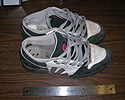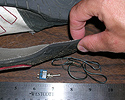What to Know Before You Go
To stay up to date, follow this link and you can subscribe to an e-mail announcement service that will notify you as changes are made.
What would you like to know that you can’t find in these links? Please take a look and post a comment with your suggestions.
How to Get Through the Line Faster
Step-By-Step Screening (WMV, 3 MB)
Female business traveler (WMV, 3 MB)
Male business traveler (WMV, 3 MB)
Traveling with a baby or small child (WMV, 3 MB)
Travelers with special needs (WMV, 3 MB)
Ad Council 3 Simple Steps to Security Video (WMV, 3.5 MB)
Windows Media Player Plug-in
Liquid Rules: 3-1-1 for Carry-Ons
Why the bag?
Learn more about packing your liquids and gels
Important information on duty-free items
Prohibited Items
Acceptable Identification at the Checkpoint
Click here to view samples of acceptable documents (PDF, 159 KB).
Safe Travel with Batteries & Devices
"Checkpoint Friendly" Laptop Bags
Special Items
Alcoholic Beverages
Batteries and Devices
Camping
Compressed Gas Cylinders
Crematory Containers and Deceased Remains
Currency, Coins, Precious Metals, or Valuable Jewelry
Firearms & Ammunition
Food & Beverages (through security checkpoints)
Hunting & Fishing
Knitting Needles, Needlepoint & Sewing
Lighters and Matches
Medications
Musical Instruments
Paintball Equipment
Parachutes
Pets
Photographic Equipment & Film
Scuba Equipment
Service Animals
Sporting Equipment
Baggage Locks
Safe Skies Luggage Locks
Travel Sentry
Travelers with Disabilities and Medical Conditions
Introduction
Before You Go
Tips For The Screening Process
Mobility Disabilities
Hearing Disabilities
Visual Disabilities
Hidden Disabilities
Pacemakers, Defibrillators, Other Implanted Medical Devices, & Metal Implants
Continuous Positive Airway Pressure (CPAP) Machine
Medical Oxygen and Respiratory-Related Equipment
Diabetes
Medications
Assistive Devices and Mobility Aids
Prosthetic Devices, Casts, and Body Braces
Walkers, Crutches, and Canes
Augmentation Devices
Orthopedic Shoes, Support Appliances, and Exterior Medical Devices
Dressings
Service Animals
Children with Disabilities
Medical Conditions and Special Situations
Military Severely Injured Program
Traveling with Children
Travel Tips
Baby Formula, Breast Milk, Juice, and Other Liquids
Children with Disabilities
Customer Service
TSA Contact Center
Claims Management Office
Discrimination
Lost & Found
Screening Process
Travel Links
Traveler Redress Inquiry Program (TRIP)
Got Feedback
Have a great weekend!!!
Blogger Bob
EoS Blog Team








